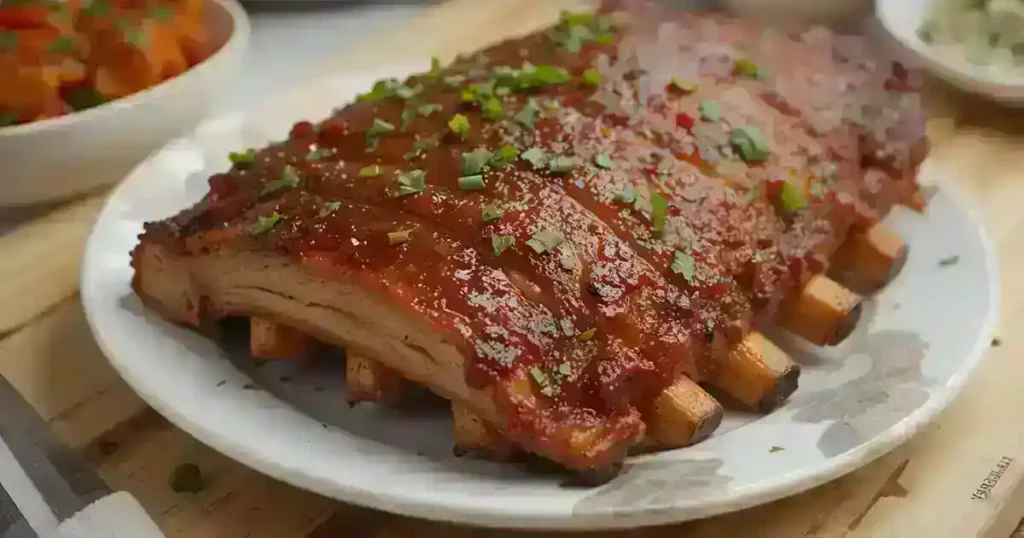Chicken ribs are an often overlooked but incredibly flavorful cut that deserve a place on your table whether you’re planning a weekend cookout, experimenting with new recipes, or simply looking for a twist on traditional chicken dishes. While many people gravitate toward chicken breasts, thighs, or wings, chicken ribs can offer a special blend of taste and texture that sets them apart. They bring a succulent, juicy flavor when cooked properly and can be prepared in a variety of ways, from grilling to oven-baking to slow cooking. Best of all, they’re usually affordable and less commonly sought after than other chicken parts, making them perfect for culinary adventurers seeking something different.
In this article, you’ll discover everything you need to know about chicken ribs how they differ from other chicken cuts, what makes them special, and how to prepare a mouthwatering recipe that will have everyone asking for seconds. We’ll delve into cooking tips, marinating secrets, and even address some frequently asked questions such as “What is a chicken rib?” and “Is it the same as chicken breast?” By the end, you’ll have a clear roadmap for creating a chicken rib dish that stands out from anything else you’ll find on the internet.
So, buckle up and get ready to explore the hidden gem of the poultry world. You’ll learn how to source the freshest chicken ribs, customize a marinade or seasoning rub that bursts with flavor, and cook them to tender, juicy perfection. Along the way, you’ll find suggestions for complementary side dishes, storage tips, and more. Let’s dive in.
Table of Contents
Why Chicken Ribs Are Special
- Unique Texture and Flavor
Chicken ribs contain both dark and lighter meat, which blends into a texture that’s tender, moist, and flavorful. Unlike chicken breast, which can dry out quickly if overcooked, chicken ribs remain relatively juicy thanks to the small bones and a bit of extra fat, meaning more margin for error when cooking. - Versatile Cooking Options
You can grill them, roast them in an oven, slow-cook them in a Crock-Pot, or even toss them into an air fryer. Chicken ribs are particularly receptive to marinades because of their structure; the meat absorbs flavors deeply, resulting in a tasty final product.
- Easy on the Budget
Because they are less popular than other cuts, you can often find chicken ribs at a slightly lower price point. Their affordability, coupled with the flavor payoff, makes them a fantastic option if you want something new without breaking the bank. - Great for Meal Prep
Chicken ribs are easy to portion out for weekly meal prep. You can marinate them in advance and cook them in large batches. They also freeze well if properly stored, making them ideal for those who like to cook in bulk and have quick, delicious meals throughout the week.
Ingredient
Chicken Ribs
2–3 pounds (approx. 1–1.3 kg)
Sourced from a local farm or butcher if possible. Choose fresh ribs trimmed of excess fat.
Marinade
- 3 tablespoons soy sauce (use low-sodium or tamari for gluten-free)
- 2 tablespoons local raw honey (or substitute with coconut sugar for a caramel note)
- 2 tablespoons apple cider vinegar (adds brightness and balance)
- 2 tablespoons olive oil (extra virgin or avocado oil for a rich, smooth finish)
- 1 teaspoon Himalayan pink salt (adjust to taste)
- 1 teaspoon freshly ground black pepper
- 1 teaspoon smoked paprika (for subtle smokiness)
- ½ teaspoon ground coriander (optional, adds citrusy undertone)
- 2 cloves garlic, minced (or 1 teaspoon garlic powder if needed)
- 1 teaspoon fresh rosemary, chopped (or thyme for an earthy twist)
Optional Flavor Additions
- ½ teaspoon chipotle powder (for mild heat)
- Juice of half a lemon (adds freshness and light acidity)
Step-by-Step Instructions
1. Prepare the Marinade
In a medium mixing bowl, whisk together soy sauce, honey (or coconut sugar), apple cider vinegar, and olive oil until combined. Add salt, pepper, smoked paprika, coriander (if using), garlic, and rosemary. Whisk again until smooth and well blended.
2. Taste the Marinade
Taste a spoonful (clean spoon!) and adjust:
- Add honey for sweetness
- More vinegar for tang
- Extra salt for boldness
3. Marinate the Chicken Ribs
Place the ribs in a large sealable bag or airtight container. Pour the marinade over the ribs and massage gently for even coating.
Refrigerate for at least 4 hours, ideally overnight for deeper flavor.
4. Bring to Room Temperature
About 30 minutes before cooking, take the ribs out of the fridge to ensure even cooking.
Choose Your Cooking Method
A. Grilling (Recommended)
- Preheat grill to 375–400°F (190–204°C)
- Oil the grates lightly
- Grill ribs for 5–6 minutes per side, until internal temp reaches 165°F (74°C)
- Brush with boiled leftover marinade during the last few minutes for added flavor
B. Oven-Baking
- Preheat oven to 400°F (200°C)
- Line a baking sheet with parchment or foil
- Bake ribs for 25–30 minutes, flipping halfway through
- Optional: Broil for 2–3 minutes at the end for caramelization (watch closely)
C. Slow Cooking
- Place marinated ribs and any remaining marinade in a slow cooker
- Cook on low for 4–6 hours until tender and fully cooked
- Optional: Broil afterward for a crisp finish
Rest and Serve
Let the ribs rest for 5 minutes after cooking to retain juices.
Serve on a platter, garnish with chopped herbs or a drizzle of sauce, and enjoy.

related topics:
Cooking Tips and Variations
Marinating Time Is Key
The marinade is what makes this recipe shine. While four hours is the minimum, letting the chicken ribs rest overnight takes the flavor and tenderness to another level. The longer soak allows every bit of seasoning to work its way deep into the meat.
Spice Levels
If you like a little heat, start small and build up. Add a pinch of cayenne or chipotle powder about a quarter teaspoon to begin with and adjust from there. For fresh heat, finely chop a chili such as jalapeño or serrano and mix it into the marinade.
Basting for Extra Flavor
For a glossy, flavorful finish, set aside a small portion of the marinade before adding the raw chicken. Warm that reserved marinade later and brush it on during the final minutes of cooking. Always keep it separate from the raw meat to stay food-safe.
Pairing Suggestions
Sides
These ribs pair beautifully with simple sides like roasted vegetables (zucchini, squash, bell peppers), creamy coleslaw, or fluffy mashed potatoes.
Sauces
A smoky homemade barbecue sauce works perfectly, or go for a cool contrast with a tangy yogurt-based dip.
Beverages
Keep it light and refreshing. Try sparkling water with lemon, chilled herbal tea, or a fruit-based iced tea to balance the savory richness of the dish.
Storage and Reheating
Refrigeration
Store leftovers in an airtight container in the fridge for up to three days.
Freezing
If you’ve made a large batch, cool the ribs completely, then freeze for up to three months. Thaw overnight in the refrigerator before reheating.
Reheating
Warm in the oven at 350°F (175°C) until heated through, or microwave in short 30‑second bursts. Avoid overcooking just heat them until they’re tender and juicy again.

Frequently Asked Questions
What is a chicken rib?
A chicken rib refers to the portion of meat that runs along the rib bones of a chicken, typically found near the breast and back area. Though not as large as pork or beef ribs, chicken ribs offer a tender, flavorful piece of meat that many home cooks often overlook. They contain a mix of darker meat around the bones, which contributes to their juiciness and robust taste. Chicken ribs may sometimes be marketed as “chicken riblets” or “rib portions” in grocery stores, but they’re essentially the same cut.
Is chicken rib the same as chicken breast?
No, chicken ribs are not the same as chicken breast. While chicken breast is a popular white meat cut that dries out more easily if overcooked, chicken ribs encompass smaller, bone-in portions that include a combination of white and dark meat. This gives chicken ribs a distinct flavor and texture. Additionally, the presence of bones helps retain moisture, making them more forgiving if you accidentally cook them a bit longer than intended.
Can we eat chicken ribs?
Absolutely! Chicken ribs are safe to eat as long as they are cooked to an internal temperature of 165°F (74°C). Just like any other part of the chicken, you must handle them with proper food safety in mind keep them refrigerated until cooking, wash your hands after handling raw poultry, and thoroughly clean any utensils or surfaces that come into contact with raw chicken. The meat around the ribs can be quite tender and is perfectly edible when prepared correctly.
How many ribs are in a chicken?
A chicken typically has seven pairs of ribs meaning 14 ribs total but the cut known as “chicken ribs” can vary depending on how the butcher breaks down the bird. Often, the section sold as “chicken ribs” or “riblets” includes smaller portions of this rib cage area. The exact number of ribs in a packaged portion can vary widely, as some butchers leave more meat on the bones than others.
Conclusion
Chicken ribs offer a tantalizing alternative to more common poultry cuts, boasting a flavorful, juicy profile that lends itself beautifully to marinades and rubs. By combining fresh ingredients like local raw honey, Himalayan pink salt, and aromatic herbs you can craft a recipe that stands out from the usual chicken fare. Whether you choose to grill, bake, or slow-cook them, chicken ribs are a hidden gem that can easily become your family’s new favorite dish.
- Marinate generously and let the flavors meld for an extended period.
- Use a thermometer to check for doneness.
- Experiment with flavors don’t be afraid to add your regional twist or a splash of something unconventional.
Ready to spice up your meal routine? Try this recipe, and let us know in the comments how it turned out for you. Feel free to share any personal touches or substitutions you made. We’d love to hear about your culinary adventures and any unique spins you add to this versatile dish. Together, let’s celebrate the delicious possibilities that chicken ribs bring to the table.

Chicken Ribs Recipe
Ingredients
Equipment
Method
- Step 1 – Make the Marinade: In a bowl, whisk soy sauce, honey, vinegar, and oil. Add salt, pepper, smoked paprika, coriander, garlic, and rosemary. Mix until smooth.
- Step 2 – Marinate: Place chicken ribs in a zip-top bag or container. Pour marinade over and massage to coat evenly. Refrigerate at least 4 hours, ideally overnight.
- Step 3 – Bring to Room Temperature: Remove ribs from fridge 30 minutes before cooking for even results.
- Step 4 – Choose Cooking Method:
- Grill: Preheat to 375–400°F (190–204°C). Oil grates. Grill 5–6 minutes per side until 165°F (74°C). Brush with reserved boiled marinade.
- Oven: Bake at 400°F (200°C) for 25–30 minutes, flipping halfway. Broil 2–3 minutes at the end for caramelization.
- Slow Cooker: Place ribs and marinade in cooker. Cook on low 4–6 hours. Optional: Broil afterward to crisp.
- Step 5 – Rest and Serve: Let ribs rest 5 minutes before serving. Garnish with chopped herbs or drizzle of sauce.


I’m really impressed with your writing skills as well as with the layout on your weblog. Is this a paid theme or did you modify it yourself? Either way keep up the nice quality writing, it is rare to see a nice blog like this one today..